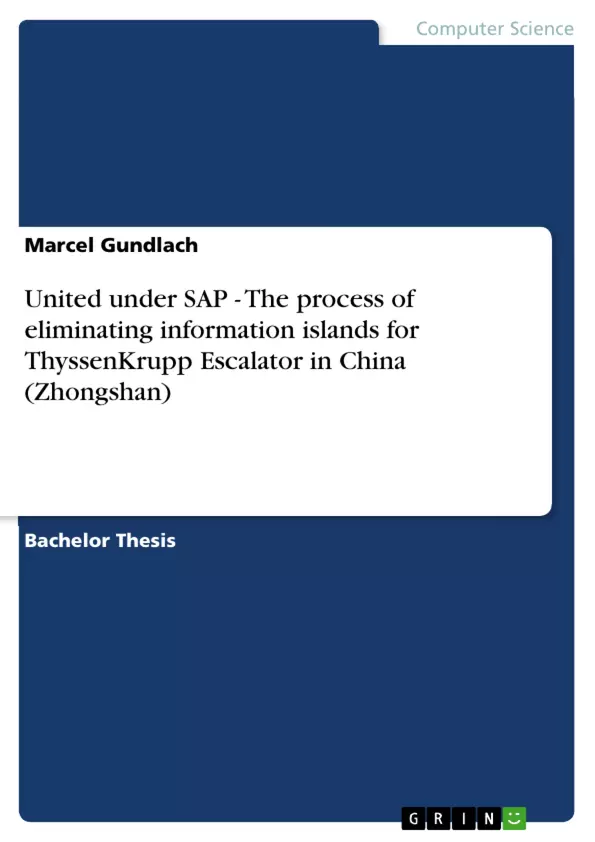Bachelor-Abschlussarbeit zur SAP Implementierung mit der ASAP Methode in einem chinesischem Unternehmen.
Untersuchungsgegestand sind Methode, Vorher-Nachhersituation, Vor- und Nachteile, Einfluss der chin. kulturellen Aspekte.
Inhaltsverzeichnis (Table of Contents)
- 1 Introduction
- 1.1 Motivation
- 1.2 Objective
- 1.3 Thesis structure
- 2 Disambiguation
- 2.1 SAP System
- 2.1.1 SAP ERP w/ ECC 6.0
- 2.1.2 Accelerated SAP (ASAP)
- 2.2 Information
- 2.2.1 Information flow
- 2.2.2 Information island
- 3 Company introduction
- 3.1 ThyssenKrupp Group
- 3.2 ThyssenKrupp Elevator
- 3.2.1 Business Unit Structure
- 3.2.2 ThyssenKrupp in Zhongshan
- 4 Influence of Chinese Culture on the business company
- 4.1 Language and mindset
- 4.2 Corporate culture and Chinese work attitude
- 4.2.1 Systematic approach
- 4.2.2 Interpersonal relationships (Guanxi)
- 5 The process of implementation
- 5.1 Prearrangement
- 5.1.1 System Requirements
- 5.1.2 (Project) Management organization and requirements
- 5.2 Actual analysis (as is)
- 5.2.1 Business processes at present
- 5.2.2 Currently used applications and procedures
- 5.2.3 Current problems
- 5.3 Target / Analysis (to be)
- 5.3.1 Project plan
- 5.3.2 Scheme of improvement
- 5.4 Realization of the project
- 5.4.1 Project Preparation
- 5.4.2 Blueprinting
- 5.4.3 Realization
- 5.4.4 Final Preparation
- 5.4.5 Go Live and Support
- 6 Reaches & Results
- 6.1 Project appraisal
- 6.1 Reaches in relation to the process of eliminating information islands
- 6.1.1 Disclosing information islands
- 6.1.2 Discovered existing information islands
- 6.1.3 Method of treatment
- 6.2 Comparison: “as is” – “to be”
- 6.3 Assets & Drawbacks
Zielsetzung und Themenschwerpunkte (Objectives and Key Themes)
This thesis investigates the methods and concepts of SAP implementation for ThyssenKrupp Escalator in Zhongshan, China, analyzing both the project approach and the before-and-after situation to enhance practical relevance. It also aims to identify the potential for improvement in the company's business processes by eliminating existing information islands, considering the specific aspects of business in China and highlighting both emerging possibilities and main barriers.
- SAP implementation methodology and its application in a Chinese context.
- Identification and analysis of information islands within ThyssenKrupp Escalator's operations in Zhongshan.
- The impact of Chinese culture and corporate culture on the implementation process.
- Comparison of "as is" and "to be" business processes after SAP implementation.
- Assessment of the project's success and identification of potential areas for future improvement.
Zusammenfassung der Kapitel (Chapter Summaries)
Chapter 1: Introduction introduces the thesis's motivation, objective, and structure. Chapter 2: Disambiguation defines key terms like "SAP System" and "Information Island." Chapter 3: Company introduction provides background information on ThyssenKrupp Group and its Zhongshan operations. Chapter 4: Influence of Chinese Culture discusses the impact of Chinese culture on business practices. Chapter 5: The process of implementation details the project's pre-arrangement, actual analysis, target analysis, and realization phases up to the "Final Preparation" stage, highlighting the ASAP methodology used.
Schlüsselwörter (Keywords)
SAP ERP implementation, information islands, Chinese business culture, business process reengineering (BPR), Accelerated SAP (ASAP) methodology, ThyssenKrupp, China, manufacturing resource planning (MRP II).
- Quote paper
- Bachelor of Science (B.Sc.) Marcel Gundlach (Author), 2008, United under SAP - The process of eliminating information islands for ThyssenKrupp Escalator in China (Zhongshan), Munich, GRIN Verlag, https://www.grin.com/document/186599



